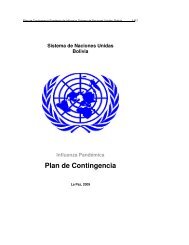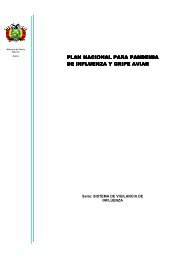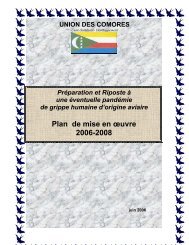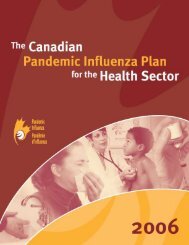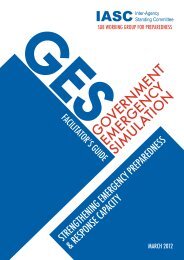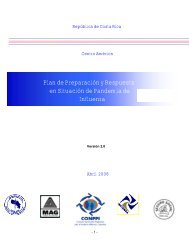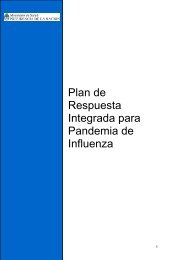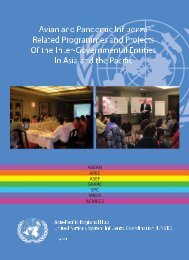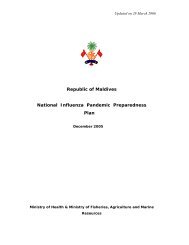Tanzania National Plan (January 2007)[1].pdf - Avian Influenza and ...
Tanzania National Plan (January 2007)[1].pdf - Avian Influenza and ...
Tanzania National Plan (January 2007)[1].pdf - Avian Influenza and ...
You also want an ePaper? Increase the reach of your titles
YUMPU automatically turns print PDFs into web optimized ePapers that Google loves.
<strong>Tanzania</strong> <strong>Avian</strong> <strong>Influenza</strong> <strong>National</strong> Emergency Preparedness & Response <strong>Plan</strong><br />
Russia (Siberia) 2005, February 2006 H5N1 Not recorded<br />
Turkey February 2006 H5N1 Recorded<br />
Egypt February 2006 H5N1 Not recorded<br />
Nigeria February 2006 H5N1 Not recorded<br />
Japan <strong>January</strong> 2006 H5N1 Not Recorded<br />
Iraq February 2006 H5N1 Recorded<br />
Russia February 2006 H5N1 Not Recorded<br />
Romania March 2006 H5N1 Not Recorded<br />
Albania March 2006 H5N1 Recorded<br />
Azerbaijan March 2006 H5N1 Not Recorded<br />
France March 2006 H5N1 Not Recorded<br />
India March 2006 H5N1 Recorded<br />
Malaysia March 2006 H5N1 Not Recorded<br />
Myanmar March 2006 H5N1 Recorded<br />
Zimbabwe February 2006 H5N2 Not Recorded<br />
Egypt March 2006 H5N1 Not Recorded<br />
Niger March 2006 H5N1 Not Recorded<br />
Nigeria : March 2006 H5N1 Not Recorded<br />
Cameroon March 2006 H5N1 Not recorded<br />
Ethiopia March 2006 H5N1 Not recorded<br />
<strong>Avian</strong> influenza can come <strong>and</strong> spread in <strong>Tanzania</strong> through a number of sources<br />
including poor bio-security measures at poultry farms, movement of poultry <strong>and</strong><br />
poultry products through trade, illegal <strong>and</strong> legal trade in wild birds <strong>and</strong> as explained<br />
below wild birds may have a significant role to play.<br />
2.3. Role of Wild Birds<br />
It has long been known that wild birds are a reservoir host for avian influenza viruses<br />
worldwide. In these birds, especially the waterfowl, particularly ducks, geese <strong>and</strong><br />
swans, influenza Viruses occur naturally as low-pathogenic avian influenza (LPAI)<br />
viruses. Prevalence of AI infection in these birds has ranged from 0.6% to 26%.<br />
However these viruses can infect domestic birds <strong>and</strong> can become highly pathogenic.<br />
Outbreaks of HPAI originating from low-pathogenic avian influenza (LPAI) viruses<br />
transmitted by wild birds to domestic poultry were infrequent during the last 40 years<br />
but, recent surveillance studies in Europe have isolated several H5 <strong>and</strong> H7 influenza<br />
A viruses from dead wild birds <strong>and</strong> illegally imported live wild birds <strong>and</strong> this has<br />
illustrated the potential of getting HPAI from this source.<br />
Research also suggests that the huge pool of viruses in wild birds, especially<br />
waterfowl, in which the virus replicates in the intestines, provides the opportunity for<br />
new combinations of H <strong>and</strong> N subtype viruses that give arise to new viruses through<br />
genetic reassortment.<br />
Migratory birds are considered to be one of the means by which the disease travels<br />
across <strong>and</strong> between continents.<br />
11


![Tanzania National Plan (January 2007)[1].pdf - Avian Influenza and ...](https://img.yumpu.com/36423433/11/500x640/tanzania-national-plan-january-20071pdf-avian-influenza-and-.jpg)
